belt HYUNDAI ENTOURAGE 2009 Owners Manual
[x] Cancel search | Manufacturer: HYUNDAI, Model Year: 2009, Model line: ENTOURAGE, Model: HYUNDAI ENTOURAGE 2009Pages: 402, PDF Size: 9.08 MB
Page 13 of 402
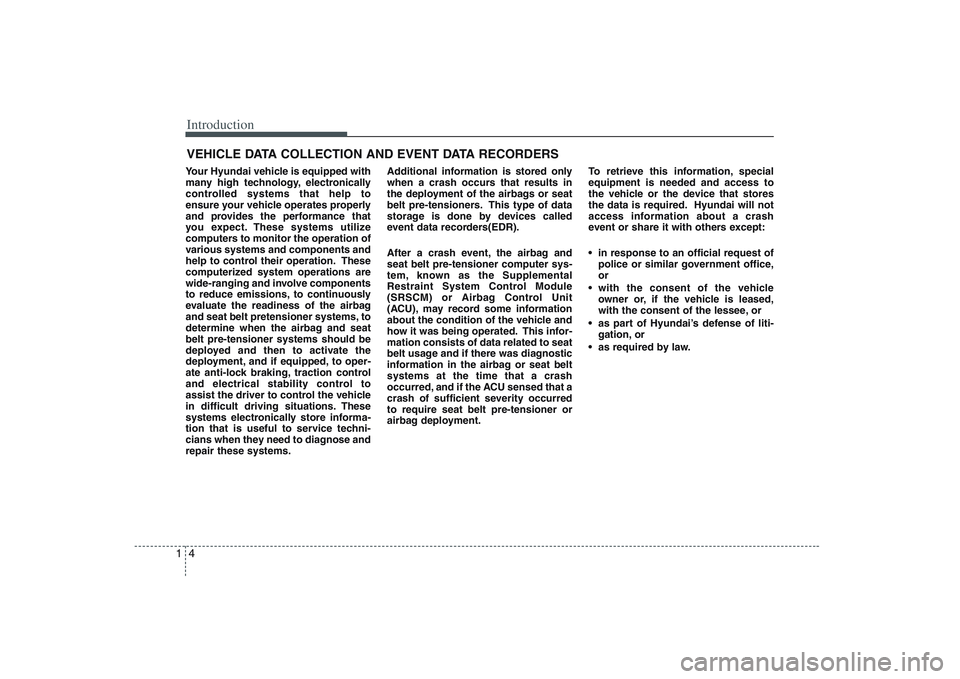
Introduction4 1Your Hyundai vehicle is equipped with
many high technology, electronically
controlled systems that help to
ensure your vehicle operates properly
and provides the performance that
you expect. These systems utilize
computers to monitor the operation of
various systems and components and
help to control their operation. These
computerized system operations are
wide-ranging and involve components
to reduce emissions, to continuously
evaluate the readiness of the airbag
and seat belt pretensioner systems, to
determine when the airbag and seat
belt pre-tensioner systems should be
deployed and then to activate the
deployment, and if equipped, to oper-
ate anti-lock braking, traction control
and electrical stability control to
assist the driver to control the vehicle
in difficult driving situations. These
systems electronically store informa-
tion that is useful to service techni-
cians when they need to diagnose and
repair these systems.Additional information is stored only
when a crash occurs that results in
the deployment of the airbags or seat
belt pre-tensioners. This type of data
storage is done by devices called
event data recorders(EDR).
After a crash event, the airbag and
seat belt pre-tensioner computer sys-
tem, known as the Supplemental
Restraint System Control Module
(SRSCM) or Airbag Control Unit
(ACU), may record some information
about the condition of the vehicle and
how it was being operated. This infor-
mation consists of data related to seat
belt usage and if there was diagnostic
information in the airbag or seat belt
systems at the time that a crash
occurred, and if the ACU sensed that a
crash of sufficient severity occurred
to require seat belt pre-tensioner or
airbag deployment.To retrieve this information, special
equipment is needed and access to
the vehicle or the device that stores
the data is required. Hyundai will not
access information about a crash
event or share it with others except:
in response to an official request of
police or similar government office,
or
with the consent of the vehicle
owner or, if the vehicle is leased,
with the consent of the lessee, or
as part of Hyundai’s defense of liti-
gation, or
as required by law.VEHICLE DATA COLLECTION AND EVENT DATA RECORDERS
Page 17 of 402

3
Keys / 3-3
Remote keyless entry / 3-4
Theft-alarm system / 3-7
Immobilizer system / 3-8
Door locks / 3-10
Power sliding door and power tailgate / 3-17
Window / 3-26
Hood / 3-29
Fuel filler lid / 3-30
Sunroof / 3-33
Seat / 3-36
Driver position memory system / 3-57
Power adjustable pedals / 3-59
Seat belts / 3-59
Child restraint system / 3-71
Air bags-advanced restraint system / 3-78
Steering wheel / 3-102
Mirrors / 3-104
Instrument cluster / 3-109
Gauges / 3-110
Trip computer / 3-113
Warnings and indicators / 3-119
Features of your vehicle
Page 53 of 402
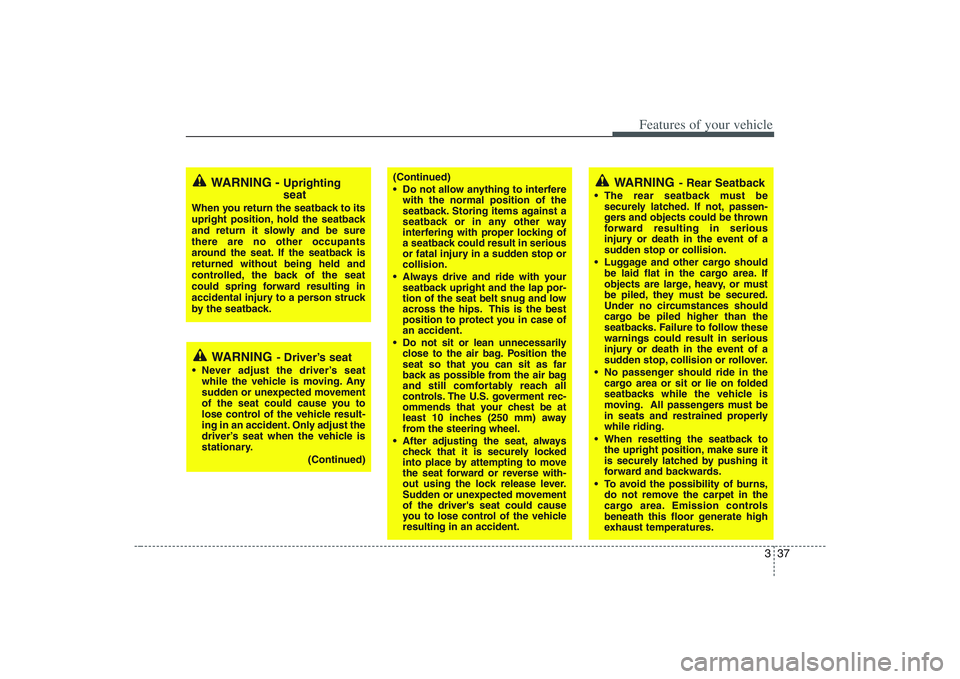
337
Features of your vehicle
WARNING
- Driver’s seat
Never adjust the driver’s seat
while the vehicle is moving. Any
sudden or unexpected movement
of the seat could cause you to
lose control of the vehicle result-
ing in an accident. Only adjust the
driver’s seat when the vehicle is
stationary.
(Continued)
(Continued)
Do not allow anything to interfere
with the normal position of the
seatback. Storing items against a
seatback or in any other way
interfering with proper locking of
a seatback could result in serious
or fatal injury in a sudden stop or
collision.
Always drive and ride with your
seatback upright and the lap por-
tion of the seat belt snug and low
across the hips. This is the best
position to protect you in case of
an accident.
Do not sit or lean unnecessarily
close to the air bag. Position the
seat so that you can sit as far
back as possible from the air bag
and still comfortably reach all
controls. The U.S. goverment rec-
ommends that your chest be at
least 10 inches (250 mm) away
from the steering wheel.
After adjusting the seat, always
check that it is securely locked
into place by attempting to move
the seat forward or reverse with-
out using the lock release lever.
Sudden or unexpected movement
of the driver's seat could cause
you to lose control of the vehicle
resulting in an accident.
WARNING -
Uprighting
seat
When you return the seatback to its
upright position, hold the seatback
and return it slowly and be sure
there are no other occupants
around the seat. If the seatback is
returned without being held and
controlled, the back of the seat
could spring forward resulting in
accidental injury to a person struck
by the seatback.
WARNING
- Rear Seatback
The rear seatback must be
securely latched. If not, passen-
gers and objects could be thrown
forward resulting in serious
injury or death in the event of a
sudden stop or collision.
Luggage and other cargo should
be laid flat in the cargo area. If
objects are large, heavy, or must
be piled, they must be secured.
Under no circumstances should
cargo be piled higher than the
seatbacks. Failure to follow these
warnings could result in serious
injury or death in the event of a
sudden stop, collision or rollover.
No passenger should ride in the
cargo area or sit or lie on folded
seatbacks while the vehicle is
moving. All passengers must be
in seats and restrained properly
while riding.
When resetting the seatback to
the upright position, make sure it
is securely latched by pushing it
forward and backwards.
To avoid the possibility of burns,
do not remove the carpet in the
cargo area. Emission controls
beneath this floor generate high
exhaust temperatures.
Page 54 of 402
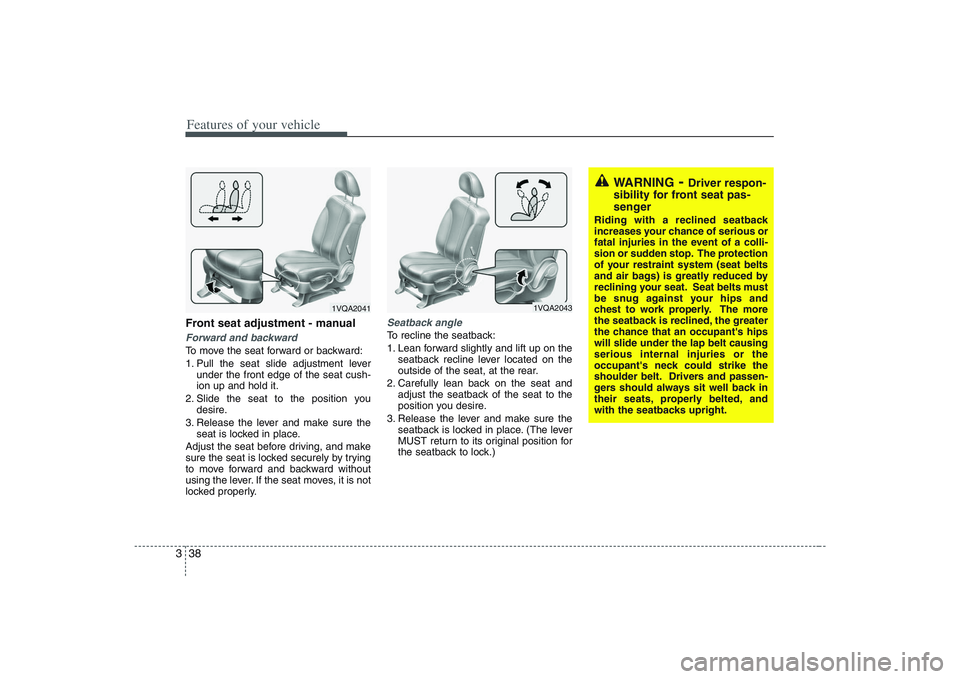
Features of your vehicle38 3Front seat adjustment - manualForward and backwardTo move the seat forward or backward:
1. Pull the seat slide adjustment lever
under the front edge of the seat cush-
ion up and hold it.
2. Slide the seat to the position you
desire.
3. Release the lever and make sure the
seat is locked in place.
Adjust the seat before driving, and make
sure the seat is locked securely by trying
to move forward and backward without
using the lever. If the seat moves, it is not
locked properly.
Seatback angleTo recline the seatback:
1. Lean forward slightly and lift up on the
seatback recline lever located on the
outside of the seat, at the rear.
2. Carefully lean back on the seat and
adjust the seatback of the seat to the
position you desire.
3. Release the lever and make sure the
seatback is locked in place. (The lever
MUST return to its original position for
the seatback to lock.)
1VQA2041
1VQA2043
WARNING
- Driver respon-
sibility for front seat pas-
senger
Riding with a reclined seatback
increases your chance of serious or
fatal injuries in the event of a colli-
sion or sudden stop. The protection
of your restraint system (seat belts
and air bags) is greatly reduced by
reclining your seat. Seat belts must
be snug against your hips and
chest to work properly. The more
the seatback is reclined, the greater
the chance that an occupant's hips
will slide under the lap belt causing
serious internal injuries or the
occupant's neck could strike the
shoulder belt. Drivers and passen-
gers should always sit well back in
their seats, properly belted, and
with the seatbacks upright.
Page 56 of 402
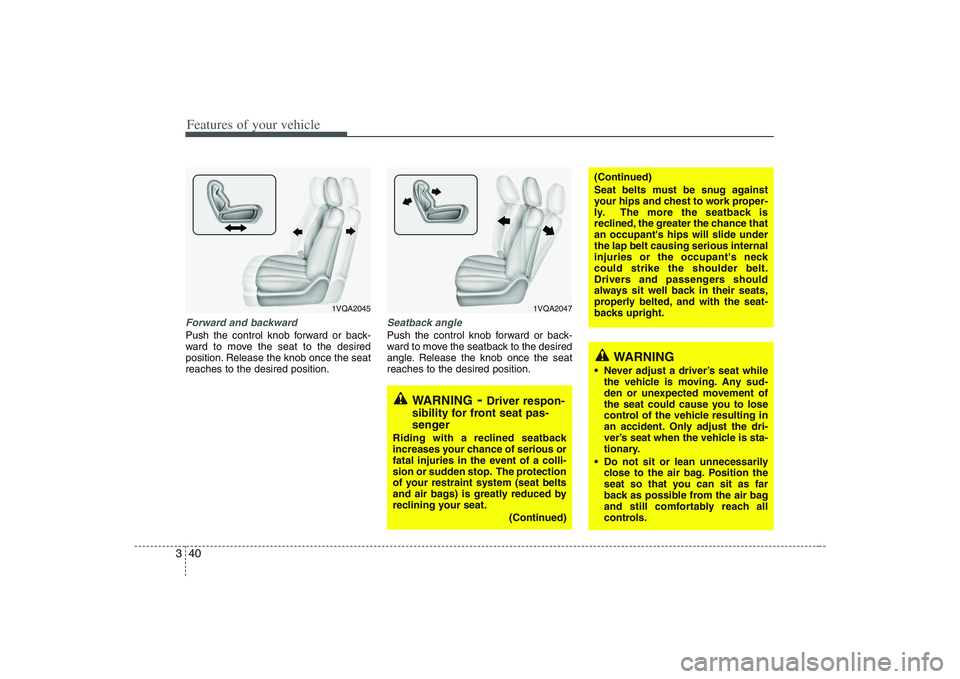
Features of your vehicle40 3Forward and backward Push the control knob forward or back-
ward to move the seat to the desired
position. Release the knob once the seat
reaches to the desired position.
Seatback anglePush the control knob forward or back-
ward to move the seatback to the desired
angle. Release the knob once the seat
reaches to the desired position.
1VQA2045
1VQA2047
WARNING
- Driver respon-
sibility for front seat pas-
senger
Riding with a reclined seatback
increases your chance of serious or
fatal injuries in the event of a colli-
sion or sudden stop. The protection
of your restraint system (seat belts
and air bags) is greatly reduced by
reclining your seat.
(Continued)
(Continued)
Seat belts must be snug against
your hips and chest to work proper-
ly. The more the seatback is
reclined, the greater the chance that
an occupant's hips will slide under
the lap belt causing serious internal
injuries or the occupant's neck
could strike the shoulder belt.
Drivers and passengers should
always sit well back in their seats,
properly belted, and with the seat-
backs upright.
WARNING
Never adjust a driver’s seat while
the vehicle is moving. Any sud-
den or unexpected movement of
the seat could cause you to lose
control of the vehicle resulting in
an accident. Only adjust the dri-
ver’s seat when the vehicle is sta-
tionary.
Do not sit or lean unnecessarily
close to the air bag. Position the
seat so that you can sit as far
back as possible from the air bag
and still comfortably reach all
controls.
Page 65 of 402
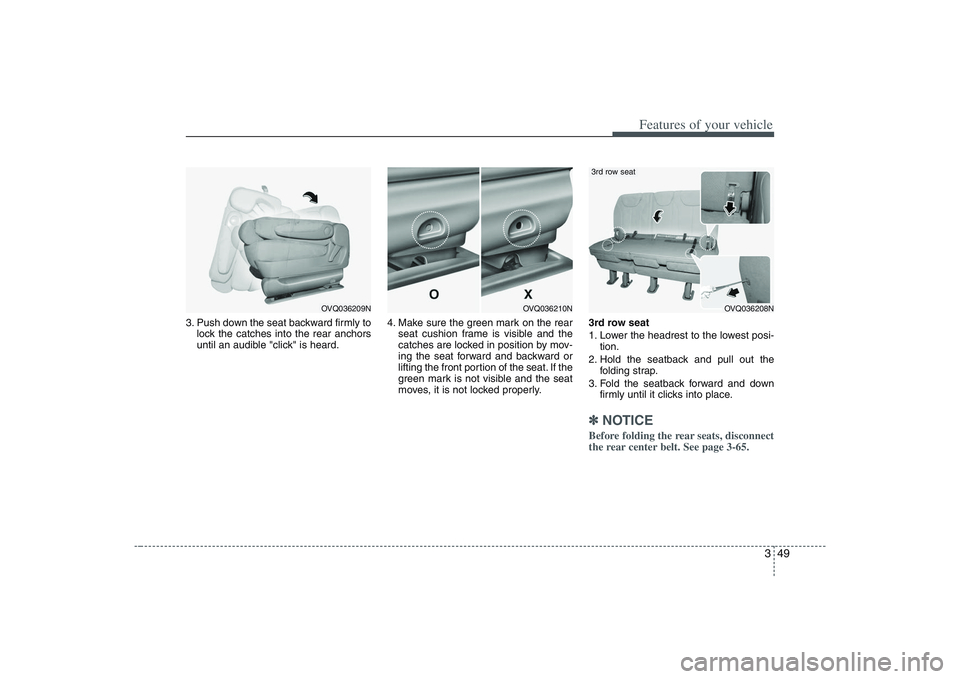
349
Features of your vehicle
3. Push down the seat backward firmly to
lock the catches into the rear anchors
until an audible "click" is heard.4. Make sure the green mark on the rear
seat cushion frame is visible and the
catches are locked in position by mov-
ing the seat forward and backward or
lifting the front portion of the seat. If the
green mark is not visible and the seat
moves, it is not locked properly.3rd row seat
1. Lower the headrest to the lowest posi-
tion.
2. Hold the seatback and pull out the
folding strap.
3. Fold the seatback forward and down
firmly until it clicks into place.
✽ ✽
NOTICEBefore folding the rear seats, disconnect
the rear center belt. See page 3-65.
OVQ036209N
OVQ036210N
OVQ036208N
3rd row seat
Page 66 of 402
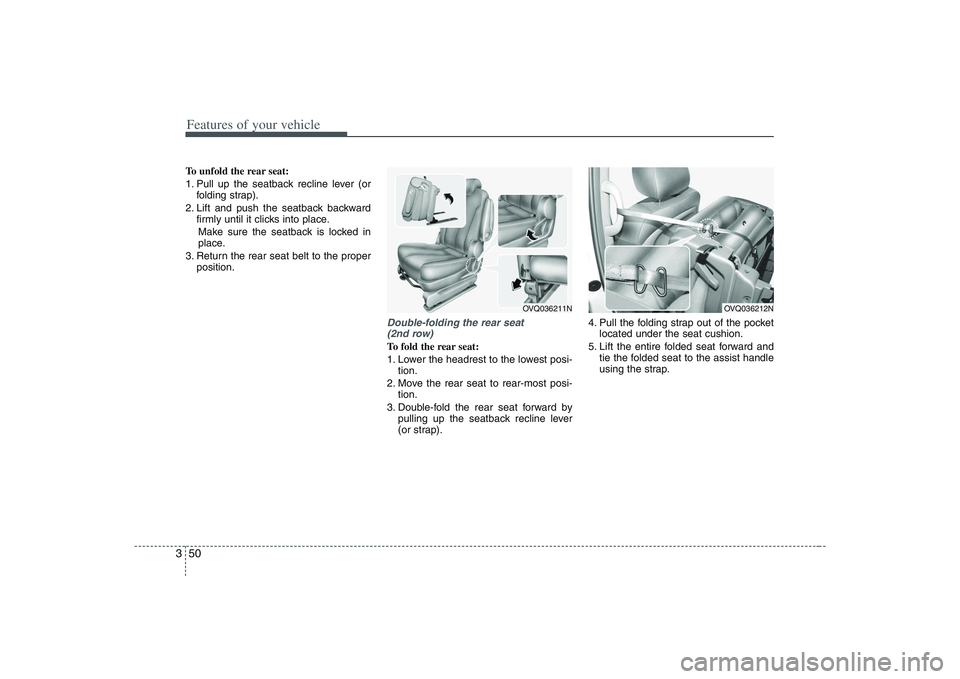
Features of your vehicle50 3To unfold the rear seat:
1. Pull up the seatback recline lever (or
folding strap).
2. Lift and push the seatback backward
firmly until it clicks into place.
Make sure the seatback is locked in
place.
3. Return the rear seat belt to the proper
position.
Double-folding the rear seat
(2nd row)To fold the rear seat:
1. Lower the headrest to the lowest posi-
tion.
2. Move the rear seat to rear-most posi-
tion.
3. Double-fold the rear seat forward by
pulling up the seatback recline lever
(or strap).4. Pull the folding strap out of the pocket
located under the seat cushion.
5. Lift the entire folded seat forward and
tie the folded seat to the assist handle
using the strap.
OVQ036211N
OVQ036212N
Page 67 of 402
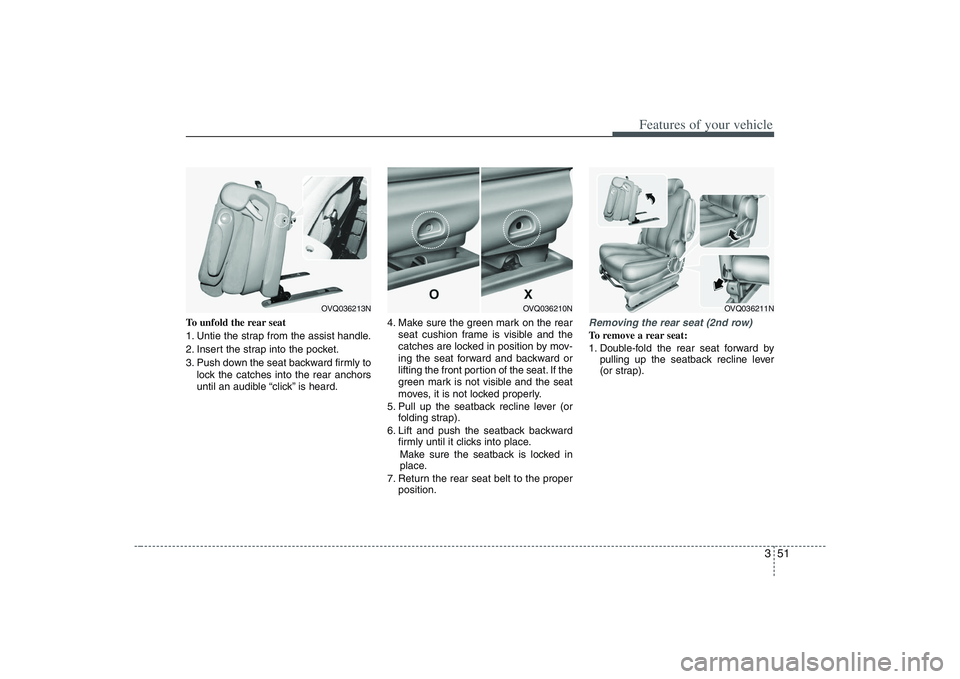
351
Features of your vehicle
To unfold the rear seat
1. Untie the strap from the assist handle.
2. Insert the strap into the pocket.
3. Push down the seat backward firmly to
lock the catches into the rear anchors
until an audible “click” is heard.4. Make sure the green mark on the rear
seat cushion frame is visible and the
catches are locked in position by mov-
ing the seat forward and backward or
lifting the front portion of the seat. If the
green mark is not visible and the seat
moves, it is not locked properly.
5. Pull up the seatback recline lever (or
folding strap).
6. Lift and push the seatback backward
firmly until it clicks into place.
Make sure the seatback is locked in
place.
7. Return the rear seat belt to the proper
position.
Removing the rear seat (2nd row)To remove a rear seat:
1. Double-fold the rear seat forward by
pulling up the seatback recline lever
(or strap).
OVQ036213N
OVQ036211N
OVQ036210N
Page 69 of 402
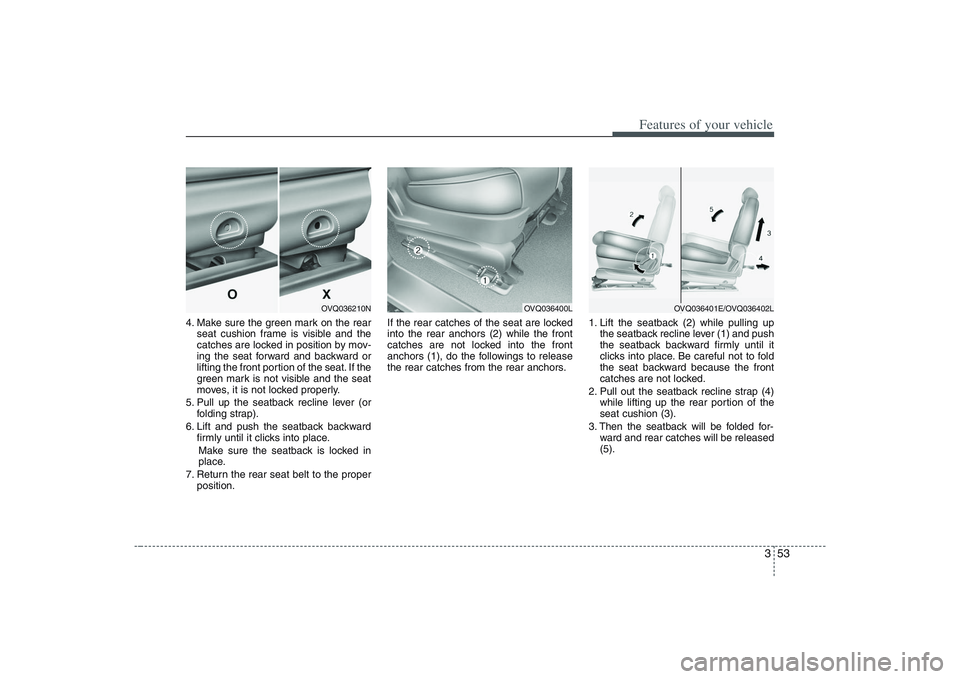
353
Features of your vehicle
4. Make sure the green mark on the rear
seat cushion frame is visible and the
catches are locked in position by mov-
ing the seat forward and backward or
lifting the front portion of the seat. If the
green mark is not visible and the seat
moves, it is not locked properly.
5. Pull up the seatback recline lever (or
folding strap).
6. Lift and push the seatback backward
firmly until it clicks into place.
Make sure the seatback is locked in
place.
7. Return the rear seat belt to the proper
position.If the rear catches of the seat are locked
into the rear anchors (2) while the front
catches are not locked into the front
anchors (1), do the followings to release
the rear catches from the rear anchors.1. Lift the seatback (2) while pulling up
the seatback recline lever (1) and push
the seatback backward firmly until it
clicks into place. Be careful not to fold
the seat backward because the front
catches are not locked.
2. Pull out the seatback recline strap (4)
while lifting up the rear portion of the
seat cushion (3).
3. Then the seatback will be folded for-
ward and rear catches will be released
(5).
OVQ036210N
OVQ036400L
OVQ036401E/OVQ036402L
Page 72 of 402
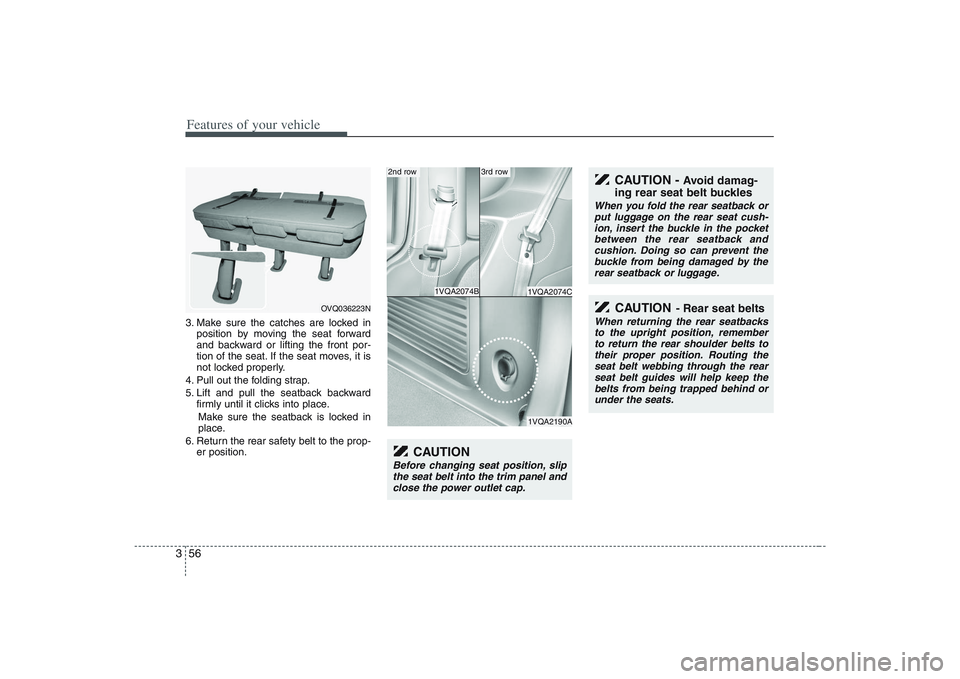
Features of your vehicle56 33. Make sure the catches are locked in
position by moving the seat forward
and backward or lifting the front por-
tion of the seat. If the seat moves, it is
not locked properly.
4. Pull out the folding strap.
5. Lift and pull the seatback backward
firmly until it clicks into place.
Make sure the seatback is locked in
place.
6. Return the rear safety belt to the prop-
er position.
OVQ036223N
CAUTION
- Rear seat belts
When returning the rear seatbacks
to the upright position, remember
to return the rear shoulder belts to
their proper position. Routing the
seat belt webbing through the rear
seat belt guides will help keep the
belts from being trapped behind or
under the seats.
CAUTION -
Avoid damag-
ing rear seat belt buckles
When you fold the rear seatback or
put luggage on the rear seat cush-
ion, insert the buckle in the pocket
between the rear seatback and
cushion. Doing so can prevent the
buckle from being damaged by the
rear seatback or luggage.
1VQA2074B
1VQA2190A1VQA2074C
2nd row
3rd row
CAUTION
Before changing seat position, slip
the seat belt into the trim panel and
close the power outlet cap.